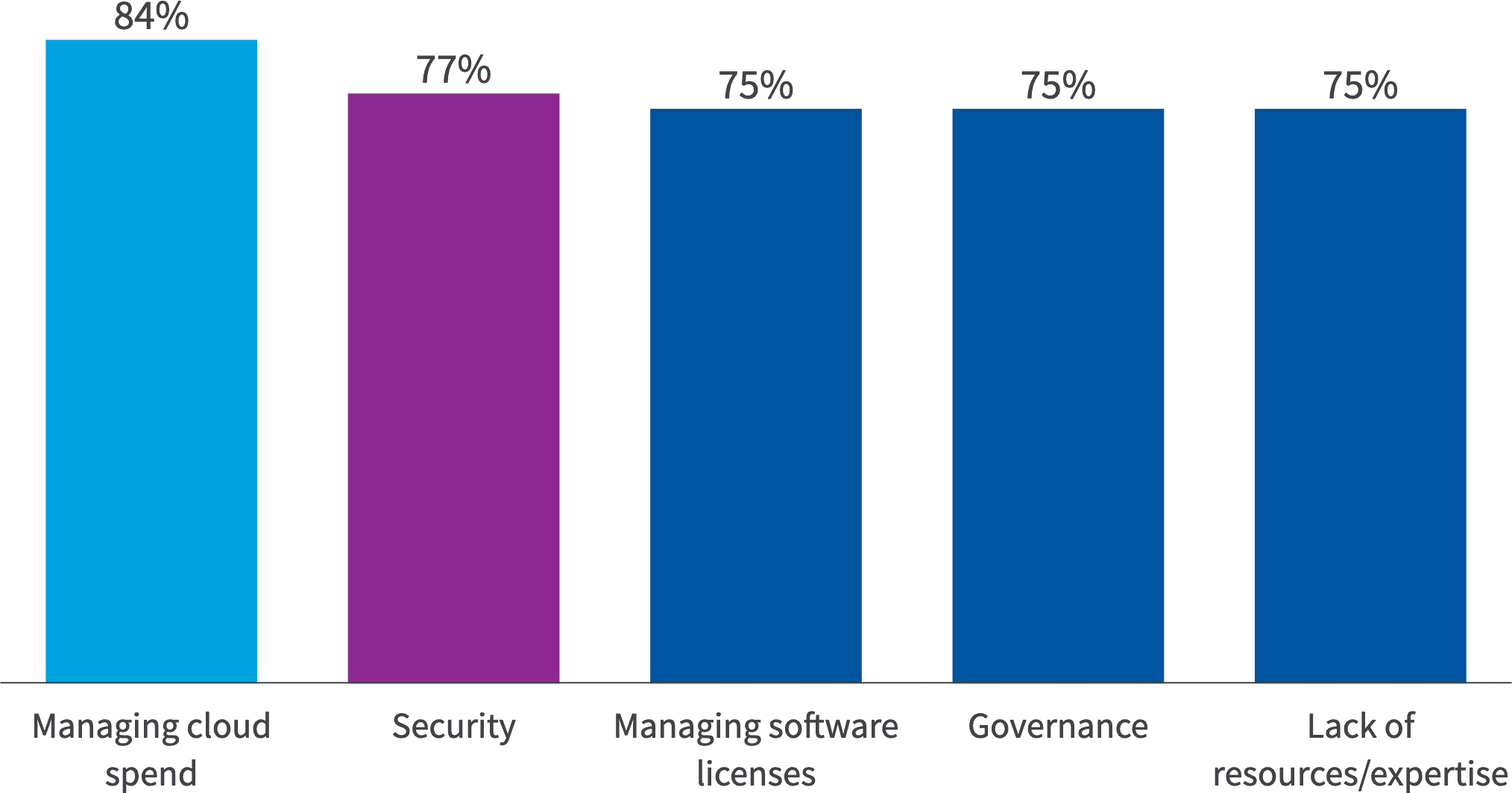The adoption of cloud technology brings numerous benefits, but it also presents several challenges that organizations must face. Here are some of the top IT cloud challenges according to the Flexera 2025 State of the Cloud Report:

As our cloud consultants help our clients with these challenges every day, we’ve gathered some of their expertise on each topic and provided solutions below:
Challenge: Managing Cloud Spend
With the pay-as-you-go pricing model, it can be challenging to track spending, especially when there are unpredictable spikes in usage. Additionally, without clear visibility and control, overprovisioning, idle resources, and a lack of cost optimization can lead to runaway costs.
Solutions
- Cost Management Tools: Utilize native cloud cost management tools to track usage and optimize expenses. These tools allow you to visualize cost trends and set alerts for when you approach your budget limits.
- Rightsizing Resources: Regularly review and adjust your cloud infrastructure to ensure that resources are right-sized to match your usage. Avoid overprovisioning, as it can lead to wasted resources.
- Auto-Scaling and Serverless Solutions: Implement auto-scaling and serverless architectures. With auto-scaling, cloud resources expand or shrink in response to demand, ensuring you’re not paying for unused capacity.
- Reserved Instances and Spot Instances: For predictable workloads, consider using reserved instances or savings plans, which offer significant discounts in exchange for committing to a fixed usage level over a specified period. Spot instances, which are less expensive but can be interrupted, are ideal for non-critical tasks.
Challenge: Security
Sensitive data on cloud servers exposes organizations to potential breaches and unauthorized access. Misconfigured cloud services or inadequate monitoring can also lead to vulnerabilities. Additionally, the shared responsibility model means that while cloud providers offer security features, customers are responsible for securing their data and applications.
Solutions
- Encryption: Encrypt data both at rest and in transit. Cloud providers offer encryption features, and it’s essential to implement end-to-end encryption for sensitive information.
- Identity and Access Management (IAM): Utilize IAM to regulate access to cloud resources. Implement policies such as least privilege access, ensuring that users have access only to the resources necessary for their roles.
- Multi-Factor Authentication (MFA): Enable MFA for all user accounts, especially for administrative access, to provide an additional layer of protection.
- Regular Security Audits: Conduct regular security assessments and audits to identify vulnerabilities and misconfigurations.
Challenge: Managing Software Licenses
The flexibility of the cloud means that software is being deployed in dynamic environments, which can lead to licensing compliance issues. If you’re not tracking licenses accurately, you may end up under- or over-licensed, which can result in financial and legal risks.
Solutions
- Centralized License Management: Implement centralized license management systems that provide visibility into software usage across your cloud environment. Many cloud providers offer tools to track licenses for popular software.
- Automated License Tracking: Use cloud management platforms or third-party tools to automate software license tracking, ensuring compliance and preventing unused licenses from incurring additional costs.
- Bring Your Own License (BYOL): If you have existing software licenses, check with your cloud provider to see if you can migrate them to the cloud using the Bring Your Own License (BYOL) model, which can help you save costs.
- Periodic Audits: Conduct regular software audits to ensure you are not over-licensed or under-licensed. This helps reduce the risk of compliance issues and potential fines.
Challenge: Governance
Unregulated usage of cloud resources, poor cost management practices, and inconsistent security policies can lead to inefficiencies and security risks. As organizations scale their cloud environments, maintaining transparent governance becomes increasingly complex.
Solutions
- Establish Governance Frameworks: Develop a strong cloud governance framework that includes clear policies for cloud usage, cost management, security, and compliance. This framework should be aligned with business objectives and set guidelines for responsible cloud adoption.
- Cloud Management Platforms (CMPs): Utilize CMPs to gain centralized control over multi-cloud environments. These platforms allow businesses to enforce governance policies across cloud accounts.
- Resource Tagging and Access Control: Use resource tagging to categorize resources by department, project, or environment. This enhances visibility, facilitates cost allocation, and aids resource tracking. Also, implement role-based access control (RBAC) to ensure only authorized personnel can provision or modify resources.
- Automation and Policies: Automate the enforcement of governance policies. For example, you can utilize tools to ensure that resources comply with your organization’s policies, such as preventing the creation of non-compliant resources.
Challenge: Lack of Resources/Expertise
Many organizations struggle with a lack of skilled resources to manage and optimize their cloud environments. This skill gap can lead to inefficient cloud architectures, inadequate cost management, and a failure to leverage cloud capabilities fully. Additionally, cloud adoption often outpaces an organization’s ability to manage its cloud resources effectively.
Solutions
- Training and Certification: Invest in cloud training and certifications for your IT staff to help them gain a deeper understanding of cloud technologies and best practices.
- Cloud Automation Tools: Utilize cloud-native automation tools to automate as much as possible. Automation reduces the need for manual intervention, streamlining operations and reducing the likelihood of human error.
- Cloud Consultants: Consider working with cloud consultants who can provide expertise and help you optimize your cloud strategy, from architecture design to cost management.
Final Thoughts
While cloud adoption offers significant benefits, managing cloud spend, security, software licenses, governance, and resources presents a variety of challenges. By implementing the right solutions, you can overcome these obstacles and unlock the full potential of cloud computing.
Is your business ready to unlock the full potential of cloud computing and reap the benefits of both operational efficiency and cost-effectiveness? ClearBridge can help – contact us to learn more!


Recent Comments